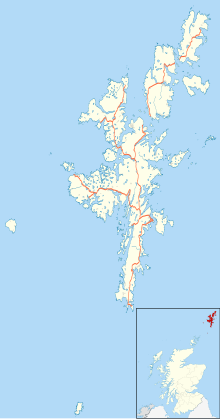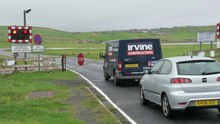Sumburgh Airport
This article uses bare URLs, which may be threatened by link rot. (May 2021) |
Sumburgh Airport | |||||||||||||||
|---|---|---|---|---|---|---|---|---|---|---|---|---|---|---|---|
 | |||||||||||||||
 | |||||||||||||||
| Summary | |||||||||||||||
| Airport type | Public | ||||||||||||||
| Owner/Operator | Highlands and Islands Airports Limited (HIAL) | ||||||||||||||
| Serves | Shetland | ||||||||||||||
| Location | Sumburgh, Shetland, Scotland | ||||||||||||||
| Elevation AMSL | 21 ft / 6 m | ||||||||||||||
| Coordinates | 59°52′53″N 01°17′38″W / 59.88139°N 1.29389°WCoordinates: 59°52′53″N 01°17′38″W / 59.88139°N 1.29389°W | ||||||||||||||
| Website | Sumburgh Airport | ||||||||||||||
| Map | |||||||||||||||
 EGPB Location in Shetland | |||||||||||||||
| Runways | |||||||||||||||
| |||||||||||||||
| Helipads | |||||||||||||||
| |||||||||||||||
| Statistics (2018) | |||||||||||||||
| |||||||||||||||
Sumburgh Airport (IATA: LSI, ICAO: EGPB) is the main airport serving Shetland in Scotland. It is located on the southern tip of the mainland, in the parish of Dunrossness, 17 NM (31 km; 20 mi) south of Lerwick.[1] The airport is owned by Highlands and Islands Airports Limited (HIAL) and served by Loganair.
On 1 April 1995, ownership of the Company transferred from the UK Civil Aviation Authority to the Secretary of State for Scotland and subsequently to the Scottish Ministers. HIAL receives subsidies from the Scottish Ministers in accordance with Section 34 of the Civil Aviation Act 1982 and is sponsored by Transport Scotland which is an Executive Agency of the Scottish Government and accountable to Scottish Ministers.
History[]
Sumburgh Links was surveyed and the grass strips laid out by Captain E. E. Fresson of Highland Airways in 1936: the airport was opened on 3 June of that year with the inaugural flight from Aberdeen (Kintore) by the De Havilland Dragon Rapide G-ACPN piloted by Fresson himself. It was also one of the first airfields to have RDF facilities, due to the frequency of low cloud and fog and the proximity of Sumburgh Head. The runways were built at the instigation of Capt. Fresson, who had proved to the Navy at Hatston (Orkney) that to maintain all-round landing facilities over the winter months runways were essential. This was taken up by the RAF after the obvious success of the Hatston experiment.
The former RAF Sumburgh airfield had three runways, two of which, although extended, remain in use by the present airport. The longest was originally 800 yd (730 m), and the shorter ran for 600 yd (550 m) from shoreline to shoreline. No. 404 Squadron operated Beaufighter Mark VI and X aircraft from this station on coastal raids against Axis shipping off the coast of Norway and in the North Sea. The airport is unusual in that it has a 550 m (1,804 ft) helicopter runway as opposed to usual helipad. The western end of runway 09/27 crosses the A970 road between Sumburgh (including the airport) and the northern mainland; access is controlled by a level crossing with barriers closed whenever a flight is taking off or landing.
Airlines and destinations[]
| Airlines | Destinations |
|---|---|
| Loganair | Aberdeen, Edinburgh, Glasgow, Kirkwall, Invernessa Seasonal: Bergen, Dundee (begins 9 May 2022),[3] London-Cityb (begins 9 May 2022)[4] |
- Notes
- ^a : Some Loganair flights to Inverness operate via Kirkwall.
- ^b : Loganair flights to London City operate via Dundee.
Cargo[]
| Airlines | Destinations |
|---|---|
| Royal Mail | Aberdeen,[5] Kirkwall[5] |
Other tenants[]
- Maritime and Coastguard Agency (Her Majesty's Coastguard)
- Bristow Helicopters
- Babcock Mission Critical Services Offshore (SAR and crew change operations)
Ground transport[]
The road distance is 25 miles (40 km) to Lerwick. There is a regular airport bus service that takes passengers there.[6]
Statistics[]
| Rank | Airport | Total passengers |
Change from 2017 |
|---|---|---|---|
| 1 | Aberdeen | 140,667 | |
| 2 | Edinburgh | 47,554 | |
| 3 | Glasgow | 29,237 | |
| 4 | Kirkwall | 9,611 | |
| 5 | Bergen | 1,367 | |
| 6 | Manchester | 802 | |
| 7 | Fair Isle | 72 | |
| 8 | Inverness | 63 | |
| 9 | Prestwick | 43 | New route |
| 10 | Tingwall | 4 |
Incidents and accidents[]
- 10 January 1977: Hawker Siddeley 748 G-AZSU, operated by Dan-Air and flying an unscheduled service from Belfast-Aldergrove, failed to stop in the landing distance available and overshot the runway. The aircraft sustained minor damage when the nose-wheel undercarriage collapsed. There were no injuries.
- 31 July 1979: Crash of Dan-Air Flight 0034, a Hawker Siddeley 748 series 1 (registration G-BEKF) operating an oil industry support flight. The aircraft failed to become airborne and crashed into the sea. The accident was due to the elevator gust-lock having become re-engaged, preventing the aircraft from rotating into a flying attitude. The aircraft was destroyed and 17 people died.
- 29 March 1981: Potez 840 F-BMCY operated by Club Aéronautique de Paris made a wheels-up landing at Sumburgh. Damage was minimal and the aircraft was parked on a stand for many months. The four Astazou engines and other useful parts were removed and the airframe dragged off to a quiet corner of the airfield to be abandoned. When the runway was extended it was saved and now resides in a private garden in North Roe in the north of Shetland. Only 8 Potez 840s were built.
- 6 November 1986: British International Helicopters Chinook crash. A Boeing 234LR Chinook helicopter crashed 2.5 mi (4.0 km) east of the airport. Only two people survived with 45 lives being lost.
- 11 June 2006 UK Air Accidents Investigation Branch recommended a safety audit of City Star Airlines after a serious incident in which a Dornier 328 crew flew close to cliffs and failed to respond correctly to terrain warnings on approach to Sumburgh Airport after a flight from Aberdeen. The aircraft landed safely. The captain involved was suspended and asked to resign after an investigation.[8]
- 23 August 2013: A Super Puma AS332 L2, operated by CHC for Total, carrying 16 passengers and 2 crew from the Borgsten Dolphin oil platform, crashed about 2 miles (3.2 km) west of the airport at 18:17 BST. The UK Air Accidents Investigation Branch identified the lack of effective monitoring of flight instruments as a cause of the crash.[9] Four of those aboard were killed.[10]
- 15 December 2014: Loganair Flight 6780 was a flight from Aberdeen to Shetland, which was struck by lightning during an attempt to land at Sumburgh Airport. The aircraft went in a steep dive before the pilots were able to recover. The flight diverted to Aberdeen.[11][12]
References[]
- ^ a b "NATS - AIS - Home". Retrieved 18 May 2016.
- ^ "UK airport data: Tables 3, 9 and 13.pdf". UK Civil Aviation Authority. Retrieved 8 April 2019.
- ^ https://www.loganair.co.uk/
- ^ https://www.loganair.co.uk/
- ^ a b "Loganair secures new Royal Mail contract". BBC News. 31 January 2017.
- ^ https://bustimes.org/services/6-lerwick-sumburgh
- ^ "Airport Data 2017". UK Civil Aviation Authority. 3 March 2017. Tables 12.1(XLS) and 12.2 (XLS). Retrieved 17 August 2019.
- ^ Flight International 20–26 March 2007
- ^ "Aircraft Accident Report AAR 1/2016 - G-WNSB, 23 August 2013". Air Accident Investigation Branch. Retrieved 23 January 2019.
- ^ "Shetland helicopter crash: Four dead named". BBC News. 24 August 2013. Retrieved 21 October 2014.
- ^ Aircraft Accident Report 2/2016. AAIB.
- ^ Staff Writers (15 March 2018). "Thunderstruck | Flight Safety Australia". Retrieved 25 May 2021.
External links[]
![]() Media related to Sumburgh Airport at Wikimedia Commons
Media related to Sumburgh Airport at Wikimedia Commons
- Airports in Shetland
- Airports established in 1936
- 1936 establishments in Scotland
- Highlands and Islands Airports
- Mainland, Shetland

